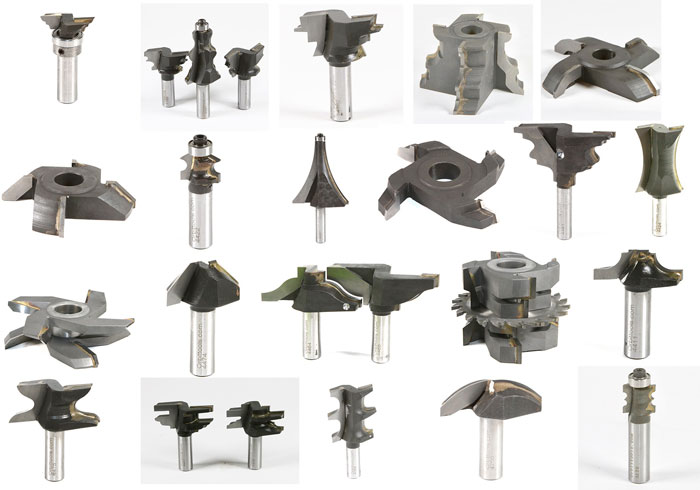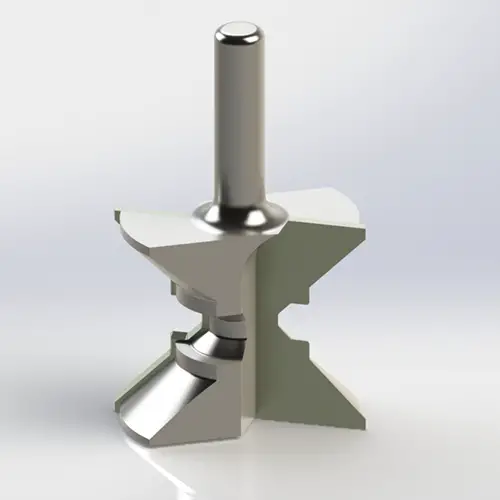How To Make Custom Router Bits? If you want to make your own custom router bits, there are a few things you need to know. Router bits are made of high-speed steel and are extremely sharp. They come in a variety of sizes and shapes, so you can choose the one that best suits your needs.
Can you Make Router Bit
There are two main types of router bits: straight and spiral. Straight router bits are used for making cuts along the grain of wood, while spiral router bits are used for making curved or decorative cuts. When choosing a router bit, you also need to consider the type of material you’ll be working with.
- Decide on the shape or design of the router bit that you want to create
- Find a solid piece of metal that is the appropriate size and hardness for the router bit
- Cut the metal into the desired shape using a grinder, saw, or another cutting tool
- Use a file to smooth out any rough edges on the new router bit
- If necessary, heat-treat the router bit to make it harder and more durable
- Alternatively, case-harden the router bit by coating it with carbon and then heating it until glowing red hot before quenching it in water
- For a standard steel router bit, sharpen the cutting edge using a grinding wheel designed for sharpening carbide tools
- 6b For high-speed steel (HSS) router bit, first grind away any damaged areas on the cutting edge using an abrasive wheel designed for HSS tools
- Next, use a grinding wheel designed specifically for HSS tools to give the cutting edge a fine finish

Credit: orbittools.com
How Can I Make My Own Router Template?
You can make your own router template in a few different ways. One way is to use a piece of plywood or MDF that is at least 1/2″ thick and has a smooth, flat surface. Cut the plywood or MDF to the size you need for your project, and then use a router with a flush-trim bit to route around all four sides of the template.
Another way is to use a laminate trimmer with a carbide-tipped bit. Set the depth of cut on the laminate trimmer so that it will just barely cut through the laminate on your countertop. Use double-sided tape to attach your template to the countertop, and then route around all four sides of the template.
What Material are the Cheapest Router Bits Made From?
There are router bits made from a variety of materials, but the cheapest ones are typically made from high-speed steel (HSS). HSS is a type of steel that contains chromium and molybdenum, which makes it resistant to wear and tear. It’s also relatively inexpensive to produce, so HSS router bits are usually the most affordable option.
How Do I Make Router Grooves?
Assuming you would like to know how to make grooves in a router:
There are several ways that you can make grooves using a router. The most common way is to use a straight bit with a fence.
This method is best for making repetitive cuts in the same spot, such as for creating dadoes or rabbets.
Another way to make grooves is by using a plunge router without a fence. This allows you more flexibility in terms of where you can place the groove, but it can be more difficult to control the depth and width of the cut.
Finally, you can also use a hand-held router with a guide bushing. This method gives you even more control over the shape and placement of your groove, but it requires more skill and experience to master.
What Should Router Bits Be Made Of?
Router bits are cutting tools used to create shapes, patterns, and designs in wood, metal, or other materials. They come in a variety of sizes and shapes to accommodate different applications. Router bits are typically made from high-carbon steel or carbide for strength and durability.
Carbide router bits are more expensive than steel router bits but they stay sharp longer and can handle tougher materials. If you do a lot of routing or if you route hardwoods or metals, carbide router bits are a good choice. Steel router bits are less expensive than carbide router bits but they dull faster.
They’re a good choice for softer woods like pine and cedar. High-carbon steel is the most common material for router bits because it’s strong and inexpensive. It can be used on softwoods, hardwoods, and metals but it won’t stay sharp as long as carbide.
Some manufacturers make hybrid router bits that have a steel body with a carbide tip. These offer the best of both worlds: strength and durability plus the ability to stay sharp longer.
Modifying router bits
Molding Router Bits
Molding router bits are specially designed to create intricate molding and trim details on woodworking projects. These bits are available in a variety of sizes and profiles to suit any design need. With the proper routing techniques, molding router bits can produce clean, precise cuts that will add a professional touch to your work.
How to Make Wood Molding With a Router
If you’re looking for a way to add some beautiful wood molding to your home, a router is a perfect tool to help you do just that. Here’s a quick guide on how to make a wood molding with a router: 1. Start by selecting the type of wood molding you want to use.
There are many different options available, so take some time to browse and find the perfect style for your home. 2. Once you’ve selected your wood molding, measure and cut it to size using a saw. Make sure the cuts are perfectly straight so that your molding will fit together nicely when installed.
3. Next, use a router to create any desired designs or patterns in the wood molding. This is where you can really get creative and make your Molding unique! 4. Finally, install the wood molding around your home using nails or screws.
Be sure to predrill holes first so that everything goes smoothly.
Decorative Moulding Router Bits
Decorative Moulding Router Bits Moulding router bits are one of the most versatile and commonly used bits for routers. There are many different types and sizes of molding router bits available, each designed for a specific type of routing or shaping.
Molding router bits can be used to create decorative edges on woodworking projects, as well as to perform more utilitarian tasks such as trimming and rabbeting. The two main types of moulding router bits are shaper cutters and straight-fluted bits. Shaper cutters have a profile that is taller than it is wide, while straight fluted bits have a profile that is wider than it is tall.
Shaper cutters are typically used to create larger mouldings and profiles, while straight-fluted bits are better suited for smaller details and trims. There are dozens of different profiles available for both shaper cutters and straight-fluted bits. Some common profiles include ogee, bead, cove, rabbet, round over, chamfer, and V-groove.
When choosing a moulding bit for your project, it is important to select the correct profile based on the desired look and feel of the finished piece. In addition to the profile, another important consideration when choosing a moulding bit is the size or diameter of the cutter. The size of the cutter will dictate the width of the resultant moulding or trim.
For example, a 1/4″ shaper cutter will produce a 1/4″ wide bead molding whereas a 3/4″ cutter will produce a 3/4″ wide bead molding. It is important to match the size of the cutter to the width of the material you will be using so that your final product has a professional appearance. Moulding router bits can be used with handheld routers or table-mounted routers depending on your needs.
How to Make Moulding With a Router
Moulding is a great way to add detail and interest to any woodworking project. With a router and some simple tools, you can easily create your own moulding profiles to add that extra touch of class. Here’s how to do it:
1. Select the router bit you will use for your moulding profile. A good all-purpose choice is a 1/4″ round-over bit, but there are many other options available depending on the look you’re going for.
2. Set up your router table according to the manufacturer’s instructions, making sure the bit is installed correctly and securely in the chuck.
3. Adjust the height of the bit so that it will cut through the wood at the desired depth – usually about 1/8″. The exact depth will depend on the size and shape of your chosen router bit as well as personal preference. Experiment with scrap pieces of wood until you get it just right.
4. Set up a stop block on one end of your workpiece so that all cuts are consistent in length. This is especially important if you’re creating multiple pieces of moulding to be used together later on. An easy way to do this is to clamp a scrap piece of wood at the desired distance from the blade, then position your workpiece against it before making each cut.
Conclusion
If you’re looking to add a unique touch to your woodworking projects, custom router bits are a great way to do it. With just a few simple tools and some basic knowledge of how to use them, you can create custom router bits that will add personality and flair to your work. First, you’ll need to gather the necessary tools.
A router table or hand-held router is essential, as is a sharpening stone or diamond wheel. You’ll also need a jig or template to guide your cuts and some patience! Once you have your tools ready, decide on the shape or design you want to cut into your wood. With just a little bit of effort, custom router bits can add tons of character and style to your woodworking projects!

I’m John Carry, also known as a woodworker I have been a professional saw expert for over 10 years. I’d work with every type of saw machine out there, and experiment to find which tools work better.
I’m always looking for ways to improve my skills and help those around me. I love my job and am always happy to share my knowledge with others.


